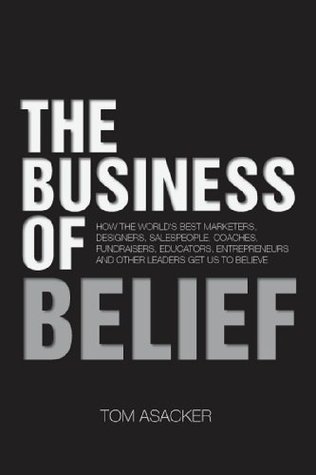More on this book
Kindle Notes & Highlights
by
Tom Asacker
Read between
February 8 - February 12, 2022
So, how do we choose? What they know that you may not is that we choose what we choose because we believe in it. And those beliefs are (or were) driven by our desires. To appreciate this powerful peculiarity of human nature—to understand how and why it happens—is to better know how to motivate yourself, make better decisions, and create conditions so that others will motivate themselves to choose you.
Beliefs are really nothing more than working assumptions. Most are provisional, conditional and have varying degrees of certainty
It seems simple, and it is. But how and why our minds work to create and nourish our beliefs is quite curious and largely invisible to us.
Your present passes through a filter of your past to create spontaneous meaning.
Everything is inherently without meaning. Except for the meaning we create.
Storytelling is all the rage in business today. But storytelling is far more than an engaging form of information transfer or an addictive form of entertainment. It’s how we make sense of the world.
Of course, control is an illusion. Most of what happens in life has little to do with our conscious decisions. We are being pushed and pulled by our environment and our instincts. But we imagine otherwise. We create a meaning-infused narrative to rationalize that we are autonomous, powerful individuals—free to be ourselves and entitled to be treated with respect.
And so eventually they will resist. No one can be forced to believe. Belief depends upon the freedom to choose.
desire is their reason to believe.
Belief, then, is a somewhat naïve, self-fulfilling prophecy. Desire drives belief, which motivates people to seek out information and act in certain ways that help them attain those desires.
Whether you believe you can or you believe you can’t, you’re probably right.
What we believe is what we desire, and what we desire is ultimately what we do. It’s the human condition.
At its core, then, altering someone’s beliefs is not an act of short-lived persuasion; it’s an act of leadership (the root of the word “lead” means “to go forth, to travel.”) And every leader knows that before you can lead people, you have to know where they want to go.
Effective leaders know that the essential first step to changing people’s behavior is to understand their perspectives and embrace their desires and beliefs. Everything else flows naturally from there.
People don’t venture down an unfamiliar path, unless they can visualize their desired destination.
We hunger for direction and inspiration. We want what’s important to us to get better—our bodies, work, home and relationships. We want to imagine ourselves transforming our lives, and the lives of others.
People are drawn across the bridge of belief by their anticipation of a better experience and a better life. Effective leaders ignite people’s imaginations by painting vivid, compelling, and personally relevant pictures—ones that move them. As John Quincy Adams made clear, “If your actions inspire others to dream more, learn more, do more and become more, you are a leader.”
Great leaders simplify the belief process by eliminating difficulties and competing options on our attention. They work really hard to make belief really easy.
Belief is a result of experience and repetition—both within and without—which makes our actions feel familiar and safe. Great leaders help create those experiences by deliberately influencing our behavior.
Behavior is a powerful influence on our feelings. But its affect will be short-lived, unless it is reinforced by our perceptions and experiences. Unless progress is made visible. Progress is movement in the direction of our desires.
To have any influence at all over our futures, or the futures of others, we must stop believing everything we think and question the validity of our lazy assumptions.
Have you been doing pretty much the same things over and over? Does it feel compulsive and unsatisfying? Then stop. Get out of your office. Leave your store. Step away from the factory. Turn off your computer. Heaven forbid, power off your cell phone. And open your child-like eyes to the reality of the world. Watch and really wonder.
The data is clear, so why take the risk? But the real risk isn’t found in the data. It’s the risk of not fully living during our one trip around the track. It’s the risk of regret. So ignore it.
So forget who you were. Forget what you’ve done. And forget what others are doing (don’t Google it!). Simply ask, What am I passionate about? Now go do that. And bingo! That’s who you are.
design determines the results.
If you don’t like the results, change the design.
Why not be the leader of your life and let your dreams hook up with you?
J.R.R. Tolkien wrote, “A single dream is more powerful than a thousand realities.” Reality is for wimps.


